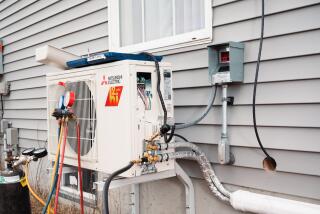Buying green electronic devices
- Share via
Sprouting up this spring for the environmentally friendly shopper: a crop of devices touting their green credentials.
Two in five adults surveyed by Forrester Research last year said they would consider environmental factors in their next electronics purchase. A similar percentage said they would pay 10% more for a television or computer that used less energy.
For those ready to shell out $1,400 for a greener boob tube, consider the Philips Eco TV. The 42-inch liquid crystal display, scheduled to hit the market in March, uses an ambient light sensor to automatically adjust to its surroundings -- it dims in dark rooms and perks up in lighter conditions. The TV also dynamically lowers the brightness setting in dark scenes, which not only saves energy but also helps bring out details in the picture.
When turned off, the set sips 0.15 of a watt of power, a tiny fraction of the power used by the average TV. It contains no lead, versus 3 to 8 pounds in a tube TV, and arrives in a box made of recycled materials.
Sony Corp. recently showed off its next-generation TV using a technology that consumes even less power than the LCD. Made of organic light-emitting diodes, the panels pull about 40% less energy than LCDs while producing a picture that has 10 times the contrast ratio, or color brilliance, of current state-of-the-art sets. It achieves the savings by lighting each pixel individually, so dark pixels don’t eat up power.
An 11-inch OLED set from Sony would set you back $2,500, but prices should come down over the next five years as other manufacturers jump in.
For a more economical entertainment makeover, home theater systems give stand-alone TVs a spiffy upgrade for a few hundred dollars. Choose one that features the Energy Star logo, which certifies that the components use less than 1 watt of power when turned off. Panasonic makes a system, due in April, that includes a DVD player, surround-sound speakers and iPod dock for less than $300.
What makes these systems green? The bundled components draw on one power supply, requiring less energy than if each had its own. Combining the pieces also cuts down on the plastics and other materials needed to produce them.
Integration, however, isn’t always greener. More than half the energy used by high-end home audio systems that pipe music into multiple rooms can be consumed while they sit idle, waiting for the “on” command. This spring, NuVo Technologies is introducing the first Energy Star-certified system, the Essentia E6G. Using a digital power supply, the system reduces energy use to 0.82 of a watt in standby mode, compared with more than 13 watts for standard systems.
If you’re seeking a greener desktop computer, CompuLab makes a pint-size PC that eats up as little energy as a night light. Its Fit-PC runs on 5 watts of power, versus 150 watts for the average desktop. The Fit-PC’s chips all sit on a small credit-card-size motherboard, reducing the amount of energy required to move data around. Although it does not come with a DVD drive or monitor, the Fit-PC does sport a 40-gigabyte hard drive and 256 megabytes of memory, for $295.
Another way to tackle home energy use is with lighting. Compact fluorescent lamps are all the rage, but they have an environmental drawback -- they contain mercury. What’s more, they often flicker, and some consumers dislike their harsh light. LED Lighting Fixtures Inc. offers an alternative: a 12-watt lamp that turns on instantly, contains no mercury and lasts 50,000 hours, twice as long as fluorescents. Its LED light closely matches that of a 65-watt incandescent bulb. Although the lamps sell for $90 or more, their makers say they pay for themselves after a few years of lower energy bills.
Don’t want to pay for any electricity? There’s Freeplay Energy’s $58 hand-charged radio, which offers an hour of listening for every minute you crank the handle.
More to Read
Inside the business of entertainment
The Wide Shot brings you news, analysis and insights on everything from streaming wars to production — and what it all means for the future.
You may occasionally receive promotional content from the Los Angeles Times.










